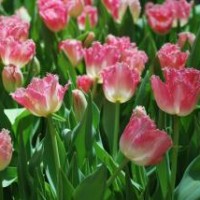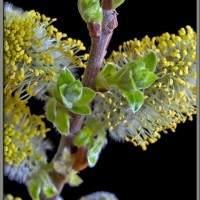
I believe God is the ultimate conservationist. He wastes nothing. He makes everything beautiful in its season. Since part of my background is horticulture, it should be no surprise that I love gardens and all the plant imagery in the Bible. It’s wonderful that mankind’s first home after Creation was the Garden of Eden…and their job was to tend it as God’s sanctuary. (Genesis 2:15 The LORD God took the man and put him in the Garden of Eden to work it and take care of it.)
I live in USDA Zone 5b and invite you to enjoy my garden along with me. It’s February and the big snow from earlier in the month is melting just enough so that my thoughts turn to spring gardening.
This month, I’m harvesting branches of forsythia for forcing in water with floral preservative in it. I cut branches with plump buds and brought them inside, letting them warm to room temperature. Then, I moistened each branch, placed them in a vase of water with preservative, and situated them in a location with indirect light where I can watch them burst forth in a sunny yellow riot of flowers. Depending on light and warmth and the date on which they are harvested, it takes between 1-2 weeks to see the lime green buds popping through the scaly wood followed by the emergence of forsythia’s characteristic yellow flowers.

I’m also excited that the pussy willow I bought last year has its flower buds swelling. The fuzzy buds of a pussy willow are actually flowers called “catkins” and are present on male pussy willow plants. Eventually, they will shed their pollen and leaves will emerge. For more beautiful close-up photos of pussy willows, check out the link.
Recently, I brought my tulip and hyacinth bulbs in from their 12 week cold treatment for forcing indoors. They make beautiful and cheerful spring flower arrangements with their leaves and flower stalks arising from bulbs atop decorative pebbles in a glass vase. Speaking of bulbs, soon the first of my outdoor bulbs will be emerging: winter aconite, snowdrops, and early snow crocus. Check out this page every month for my garden update.
2 Comments
What are the most important garden chores for March and April?
How do I know when my compost is “cooked” enough to use?
Great questions, Teri! My top 3 to-do items for March include (1) deer prevention, (2) starting seeds and cuttings, and (3) spring cleanup. Articles on each of these will be posted shortly.
Once we turn the corner on April (6 weeks before our last frost date of May 15th), starting seeds becomes less important than monitoring seedlings and continuing to propagate with cuttings. Yard cleanup will take a top priority because if it is done right early on, you’ll reap the rewards of an easier yard all summer long. My new cool-season plantings begin in April.
Finally, you’ll know your compost has “cooked” (i.e. decomposed) enough when it is dark brown and crumbly with few discernable leaves and sticks. The process slows way down in winter whereas in the summer it may take as little as 6 weeks from start to finish. Cooking (as in pasteurizing) compost is a whole different issue and would be an outdoor task in order to make compost suitable for houseplants or indoor use. I’d rather skip using compost for indoor plants and keep my neighborly friendships intact since it’s a very stinky task. 😉